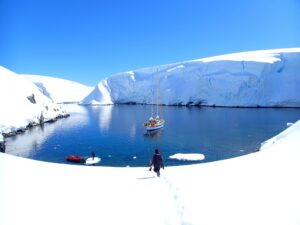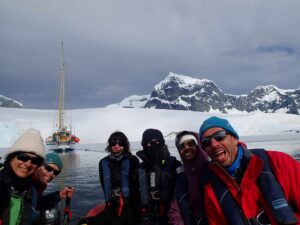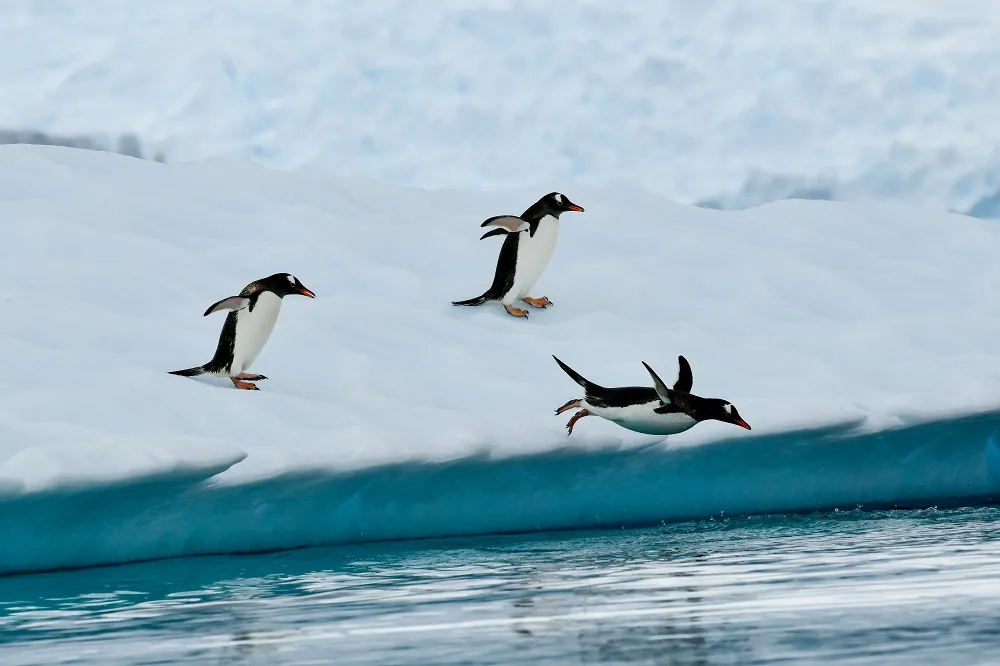Quixote- Southern Oceans Expedition Microplastics Research update
Abby Barrows
Captain Fede and Expedition Leader, Laura of Quixote Expeditions have been active contributors to the Global Microplastic Initiative since I first developed the project with Adventure Scientists in 2013. They have diligently collected 1-liter grab samples on their seasonal expeditions to the Antarctic peninsula, Chilean Fjords, Isla de los Estados, the Falkland Islands and Uruguay. Their samples provide important information on microplastic pollution in an understudied and hard to reach region of the world. When I first heard about their guest scientist program, I was intrigued. Since microplastic distribution in the Southern Oceans is still not well understood, and I am always keen to get out in the field, I designed a study.
Southern Oceans Study Goals:
1. To better understand the sources, types and abundance of plastic pollution in remote oceans environments.
2. To help fill knowledge gaps in the field of microplastic research through collaboration with established researchers and produce a peer-reviewed academic publication comparing three distinct latitudinal regions.
3. To field trial and standardize a sampling technique (volume reduction via manual hand-pump) to advance microplastic research for both academic and citizen sciences
4. Contribute data to an understudied region for Adventure Scientist’s Global Microplastic Initiative
On this trip I’m taking two main types of samples. 1. Grab samples consist of using a 1-liter bottle to collect surface water. The water is then shipped to my lab in Maine for processing and analysis of microplastic content. Over 2,800 grab samples have been collected in marine and freshwater environments for Adventure Scientist’s Global Microplastic Initiative. Grab samples collected on the Quixote Expedition Southern Ocean Passage directly contribute to the initiative and act as a 1-liter comparison for the volume reduction sampling (the second type of sampling). 2. The volume reduction apparatus allows for a large volume of sea water to be hand-pumped over a filter, which reduces sample processing time and possible exposure to contamination in a lab. This method of sample collection also bypasses the need to ship heavy water samples for analysis.
As with any field research, especially when testing a new sampling method, there are surprises and unexpected hurdles to overcome. Although I had assembled and tested the volume reduction sampling apparatus before arriving in Ushuaia, it became clear that I should have done additional trials in salt water and addressed the slow flow rate when additional filters were just a few internet clicks away. Three days before we were due to depart, I set up my apparatus aboard Ocean Tramp and realized that the hose I had brought for the saltwater intake was too short to reach the water from the stern of the boat. There was another hose onboard that was the correct diameter and fit nicely onto the manual bilge pump which I had mounted on to a piece of plywood (so I could kneel on it to hold the pump steady while pumping). Once I re-situated the hose, I could pump water easily but I could not get the water to pass through the filter. So my question was, is the pump not strong enough? Is there residual crud in the hose that is immediately blocking the filter? I flushed the hose with seawater, but still had no luck. Thinking that new hoses might solve the problem, I went out and with my limited Spanish vocabulary bought a new intake hose and some fittings. The rest of the afternoon I spent assembling the new parts (Laura fittingly called it ‘adult lego’) and tried pumping again. Unfortunately, there was no change. No water was passing through the filter. Perhaps all that was needed was more force? I reassembled the hoses, fittings and inline filter to fit the submersible pump that is used aboard to wash the anchor and anchor chain. We plugged in the hose and…again nothing passed through the filter. Now without question, different filters needed to be obtained. I was feeling at whit’s end, we departed the next day and there seemed high potential that my whole study had to be scrapped.
Laura and Fede tapped into the network that they had established over the years of being based in Ushuaia. One contact led to the local science institution (CADIC). On the day of departure, I walked to the CADIC, my filters in hand, and after some haggling, exchanged mine for some of a different material. Feeling very optimistic, we sailed from Ushuaia to our first anchorage. Once we were situated in our anchorage for the night, I got to work. I excitedly put the new filter into the in-line filter holder, extended the intake hose into the sea surface below and began pumping. The water came up through the hose and stopped as though hitting a wall at the filter. Not even a trickle of water coming through. Nothing. So, plan C, or was it D at this point? I cut 47mm diameter circles (using triple rinsed equipment and a running air blank for the duration to record any particles in the air that may contaminated the filter pre-sampling) out of the extra 5-micron filter that Fede had for the boat’s water filtration system.
The moment of truth. Following my protocol of flushing the pump system and positioning my body downwind of the sample I placed the new 5-micron filter into the apparatus. Hurriedly I pumped the water up the hose and through the manual hand pump—SUCCESS! The water passed through the filter rapidly and very quickly I measured 2 liters of water sampled, I continued pumping until reaching 10 liters and in my elation (and also wanting to get back on my projected sampling schedule) I did another sample of 12 liters and then a 2-liter filtrate blank. The simple set up of hoses and bilge pump worked beautifully, just has I had hoped.
Every day since, we have taken samples off the stern of the boat, along with some corresponding grab samples. We also sampled out of the zodiac, which went even more quickly due to pump proximity to the water. At the narrowest part of land on Isla de los Estados we stuffed the apparatus into a bag and hiked it to the southern coast and did a shore sampling. This took a little more finagling: Laura stood out in the water with the intake hose tied to a stick to hold it where we wanted in the water and away from the stirred up sediment caused by the minor wave action. We had to move up the beach at one point, since the tide was incoming and the pumping was slow due to the algae in the water. Overall volume reduction is doable from the shore, but definitely better lends itself to sampling from a boat or a platform of sorts.
We now have left land and night anchorages behind for the next day and a half while we transit to the Falkland Island. We will try our first sampling underway, slowing the boat but hopefully not stopping completely. Yay research!
Day 6 Microplastic By the Numbers:
Volume Reduced samples: 8
Grab Samples: 6
Air blank samples: 3
Water filtrate blanks: 2
Water processed through the volume reduction apparatus: 102 liters
Water collected via grab sample: 8 liters







